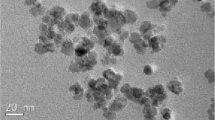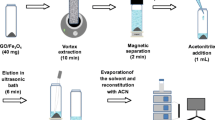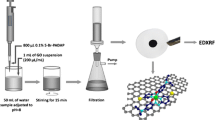Abstract
Bisphenol A (BPA), an endocrine-disrupting chemical, has received much attention from researchers and the general public. In this paper, a novel method of determining BPA at trace levels was developed, using magnetic reduced graphene oxide (rGO-Fe3O4)-based solid-phase extraction coupled with dispersive liquid–liquid microextraction (DLLME), followed by high-performance liquid chromatographic determination. The rGO-Fe3O4 was prepared and then characterized by Fourier transform infrared spectroscopy, transmission electron microscopy, and vibrating sample magnetometry. The greatest saturation magnetization of rGO-Fe3O4 was up to 43.8 emu g−1, which allowed rapid isolation of the rGO-Fe3O4 from solutions upon applying an appropriate magnetic field. The effects of solution pH, adsorbent amount, type and volume of eluent and extraction solvent, extraction time, and salt concentration on the extraction efficiency of BPA were examined and optimized. Under the optimum conditions, an enrichment factor of 5217 and an LOD of 0.01 μg L−1 for BPA were obtained. The reusability of rGO-Fe3O4 for at least 12 repeated cycles without any significant decrease in the extraction recovery of BPA was demonstrated. The proposed method was applied to the determination of BPA in different real water samples, with relative recoveries of 84.8–104.9 % and RSDs of 0.8–8.3 % in the spiked concentration range 1–10 μg L−1.






Similar content being viewed by others
References
Abrams CF, Kremer K. Combined coarse-grained and atomistic simulation of liquid bisphenol A–polycarbonate: liquid packing and intramolecular structure. Macromolecules. 2003;36(1):260–7.
Tiwari D, Vanage G. Mutagenic effect of bisphenol A on adult rat male germ cells and their fertility. Reprod Toxicol. 2013;40:60–8.
Vandenberg LN, Hauser R, Marcus M, Olea N, Welshons WV. Human exposure to bisphenol A (BPA). Reprod Toxicol. 2007;24(2):139–77.
Belfroid A, van Velzen M, van der Horst B, Vethaak D. Occurrence of bisphenol A in surface water and uptake in fish: evaluation of field measurements. Chemosphere. 2002;49(1):97–103.
Lázaro Martínez JM, Denis MFL, Denaday LR, Dell’Orto VC. Development and characterization of a new polyampholyte surfactant complex applied to the solid phase extraction of bisphenol A. Talanta. 2009;80:789–96.
Chen J, Ma X, Wu Y. Silica gel chemically modified with ionic liquid as novel sorbent for solid-phase extraction and preconcentration of lead from beer and tea drink samples followed by flame atomic absorption spectrometric determination. Food Anal Methods. 2014;7(5):1083–9.
Maragou NC, Lampi EN, Thomaidis NS, Koupparis MA. Determination of bisphenol A in milk by solid phase extraction and liquid chromatography–mass spectrometry. J Chromatogr A. 2006;1129(2):165–73.
Cai Y, Jiang G, Liu J, Zhou Q. Multiwalled carbon nanotubes as a solid-phase extraction adsorbent for the determination of bisphenol A, 4-n-nonylphenol, and 4-tert-octylphenol. Anal Chem. 2003;75(10):2517–21.
Alexandrou LD, Spencer MJS, Morrison PD, Meehan BJ, Jones OA. Micro versus macro solid phase extraction for monitoring water contaminants: a preliminary study using trihalomethanes. Sci Total Environ. 2015;512:210–4.
Xu J, Wang L, Zhu Y. Decontamination of bisphenol A from aqueous solution by graphene adsorption. Langmuir. 2012;28(22):8418–25.
Zhang F, Zheng B, Zhang J, Huang X, Liu H, Guo S, et al. Horseradish peroxidase immobilized on graphene oxide: physical properties and applications in phenolic compound removal. J Phys Chem C. 2010;114(18):8469–73.
Zhang Y, Cheng Y, Chen N, Zhou Y, Li B, Gu W, et al. Recyclable removal of bisphenol A from aqueous solution by reduced graphene oxide–magnetic nanoparticles: adsorption and desorption. J Colloid Interf Sci. 2014;421:85–92.
Ziaei E, Mehdinia A, Jabbari A. A novel hierarchical nanobiocomposite of graphene oxide–magnetic chitosan grafted with mercapto as a solid-phase extraction sorbent for the determination of mercury ions in environmental water samples. Anal Chim Acta. 2014;850:49–56.
Wang R, Ma Y, Li C, Li T, Du X. Preparation and adsorption property of glutathione magnetic molecularly imprinted polymers. Acta Chim Sinica. 2014;72:577–82.
Prakash A, Chandra S, Bahadur D. Structural, magnetic, and textural properties of iron oxide-reduced graphene oxide hybrids and their use for the electrochemical detection of chromium. Carbon. 2012;50(11):4209–19.
Zou J, Ma X, Dang Y, Chen Y. Trace determination of cadmium(II) and copper(II) in environmental water samples by solid-phase extraction using a novel ionic liquid-modified composite sorbent combined with flame atomic absorption spectrometry. J Anal At Spectrom. 2014;29(9):1692–7.
Herrero-Latorre C, Barciela-García J, García-Martín S, Pena-Crecente RM, Otárola-Jiménez J. Magnetic solid-phase extraction using carbon nanotubes as sorbents: a review. Anal Chim Acta. 2015;892:10–26.
Chen Y, Ma X, Huang M, Peng J, Li C. Use of a new magnetic ion-imprinted nanocomposite adsorbent for selective and rapid preconcentration and determination of trace nickel by flame atomic absorption spectrometry. Anal Methods. 2016;8(4):824–9.
Bagheri H, Asgharinezhad AA, Ebrahimzadeh H. Determination of trace amounts of Cd(II), Cu(II), and Ni(II) in food samples using a novel functionalized magnetic nanosorbent. Food Anal Methods. 2016;9(4):876–88.
Ebrahimpour B, Yamini Y, Seidi S, Tajik M. Nano polypyrrole-coated magnetic solid phase extraction followed by dispersive liquid phase microextraction for trace determination of megestrol acetate and levonorgestrel. Anal Chim Acta. 2015;885:98–105.
Jiao Z, Zhu D, Yao W. Combination of accelerated solvent extraction and micro-solid-phase extraction for determination of trace antibiotics in food samples. Food Anal Methods. 2015;8(9):2163–8.
Rezaee M, Assadi Y, Hosseini MRM, Aghaee E, Ahmadi F, Berijani S. Determination of organic compounds in water using dispersive liquid–liquid microextraction. J Chromatogr A. 2006;1116(1):1–9.
Gao Z, Ma X. Speciation analysis of mercury in water samples using dispersive liquid–liquid microextraction combined with high-performance liquid chromatography. Anal Chim Acta. 2011;702(1):50–5.
Gaubeur I, Aguirre MÁ, Kovachev N, Hidalgo M, Canals A. Speciation of chromium by dispersive liquid–liquid microextraction followed by laser-induced breakdown spectrometry detection (DLLME–LIBS). J Anal At Spectrom. 2015;30(12):2541–7.
Peng G, He Q, Lu Y, Mmereki D, Zhong Z, Jiang K, et al. Dispersive solid phase extraction followed by low-toxicity vortex-assisted liquid–liquid microextraction for the determination of organophosphorus pesticides by high-performance liquid chromatography. Anal Methods. 2016;8(12):2684–90.
Marcano DC, Kosynkin DV, Berlin JM, Sinitskii A, Sun Z, Slesarev A, et al. Improved synthesis of graphene oxide. ACS Nano. 2010;4(8):4806–14.
Chandra V, Park J, Chun Y, Lee JW, Hwang IC, Kim KS. Water-dispersible magnetite-reduced graphene oxide composites for arsenic removal. ACS Nano. 2010;4(7):3979–86.
Szabó T, Berkesi O, Dékány I. DRIFT study of deuterium-exchanged graphite oxide. Carbon. 2005;43(15):3186–9.
Yang X, Zhang X, Ma Y, Huang Y, Wang Y, Chen Y. Superparamagnetic graphene oxide–Fe3O4 nanoparticles hybrid for controlled targeted drug carriers. J Mat Chem. 2009;19(18):2710–4.
Zhang S, Niu H, Hu Z, Cai Y, Shi Y. Preparation of carbon coated Fe 3 O 4 nanoparticles and their application for solid-phase extraction of polycyclic aromatic hydrocarbons from environmental water samples. J Chromatogr A. 2010;1217(29):4757–64.
Fan Y, Hu Z, Chen M, Shen T, Zhu Y. Analysis of phenolic compounds by ionic liquid based liquid-liquid extraction coupled with high performance liquid chromatography. Chin J Anal Chem. 2008;36:1157–61.
Wang L, Zhang Z, Xu X, Zhang D, Wang F, Zhang L. Simultaneous determination of four trace level endocrine disrupting compounds in environmental samples by solid-phase microextraction coupled with HPLC. Talanta. 2015;142:97–103.
Tan XW, Song YX, Wei RP, Yi G. Determination of trace bisphenol-A in water using three-phase hollow fiber liquid phase microextraction coupled with high performance liquid chromatography. Chin J Anal Chem. 2012;40:1409–14.
Hu X, Wu X, Yang F, Wang Q, He C, Liu S. Novel surface dummy molecularly imprinted silica as sorbent for solid-phase extraction of bisphenol A from water samples. Talanta. 2015;148:29–36.
Fatemi MH, Hadjmohammadi MR, Shakeri P. Evaluation of alcoholic-assisted dispersive liquid-liquid microextraction of bisphenol A in water samples using an experimental design. Acta Chromatogr. 2014;26(3):401–12.
Acknowledgments
The authors gratefully acknowledge financial support from the National Natural Science Foundation of China (no. 41272262), the Science and Technology Planning Project of Guangdong Province, China (no. 2016A040403112), and the Major Projects (Natural Science) of Education Department of Guangdong Province, China (261555101).




